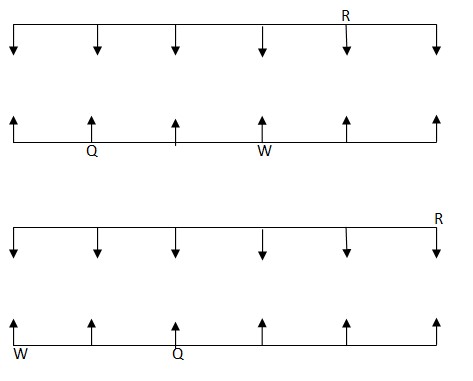Question
How many persons sit between Y and the one who faces
R? Study the following information carefully and answer the questions given below. Twelve persons are sitting in two parallel rows. The persons in row 1 - P, R, T, V, X, and Z are facing towards south and the persons in row 2 - Q, S, U, W, Y, and A are facing towards north, but not necessarily in the same order. The person, who faces R, sits third to the right of Q. Only one person sits between Q and W. V sits second to the right of P, where neither of them faces Q nor sits on the extreme ends of the row. S sits on the extreme end of the row but doesn’t face R. Only one person sits between A and U, who neither sits adjacent to S nor Q. Z sits to the right of X but neither faces S and A nor sits on the extreme ends of the row.Solution
The person, who faces R, sits third to the right of Q. Only one person sits between Q and W.  Case-2
Case-2  Case-4
Case-4  V sits second to the right of P, where neither of them faces Q nor sits on the extreme ends of the row. S sits on the extreme end of the row but doesn’t face R. Here, cases 2 and 3 get eliminated. Case-1
V sits second to the right of P, where neither of them faces Q nor sits on the extreme ends of the row. S sits on the extreme end of the row but doesn’t face R. Here, cases 2 and 3 get eliminated. Case-1  Only one person sits between A and U, who neither sits adjacent to S nor Q. Z sits to the right of X but neither faces S and A nor sits on the extreme ends of the row. Here, case 1 gets eliminated.
Only one person sits between A and U, who neither sits adjacent to S nor Q. Z sits to the right of X but neither faces S and A nor sits on the extreme ends of the row. Here, case 1 gets eliminated. 
From the top of a cliff 100 meter high, the angles of depression of the top and bottom of a tower are 45° and 60° respectively. The height of the towe...
The outer radius of a hollow metallic spherical ball is 12cm while the thickness of the metal used to make it is 8 cm. Find the volume of the metal used...
Outer diameter of 20 cm long pipe is 25 cm. If the thickness of the metal in the pipe is 1 cm. Find the total surface area of the pipe?
A Solid Cone of height 18cm diameter of its base 36cm is cut from a wooden Solid sphere of radius 18cm. the percentage of wood wasted is ?
In a rhombus, the ratio of its diagonals is 2:5, and the difference between their lengths is 12 cm. Find its area.
- The radii of two cylinders are in the ratio of 5: 6 and their heights are in the ratio of 4: 3. The ratio of their volume is
The perimeter of 4 squares is 20 cm, 24 cm, 32 cm and 36 cm respectively. What will be the area of the square having perimeter equal to sum of edges of ...
The perimeter of a rectangle is 100% more than perimeter of a square of side 20 cm. If the length of rectangle is 200% more than side of square then fin...
The sum of the total surface areas of two cubes is 1326 cm2. If the product of the length of their edges is 98 cm2, then find the ...
How many spherical bullets can be made out of a lead cylinder 45 cm high and 27 cm radius, each bullet being 3 cm in diameter?
Relevant for Exams:


